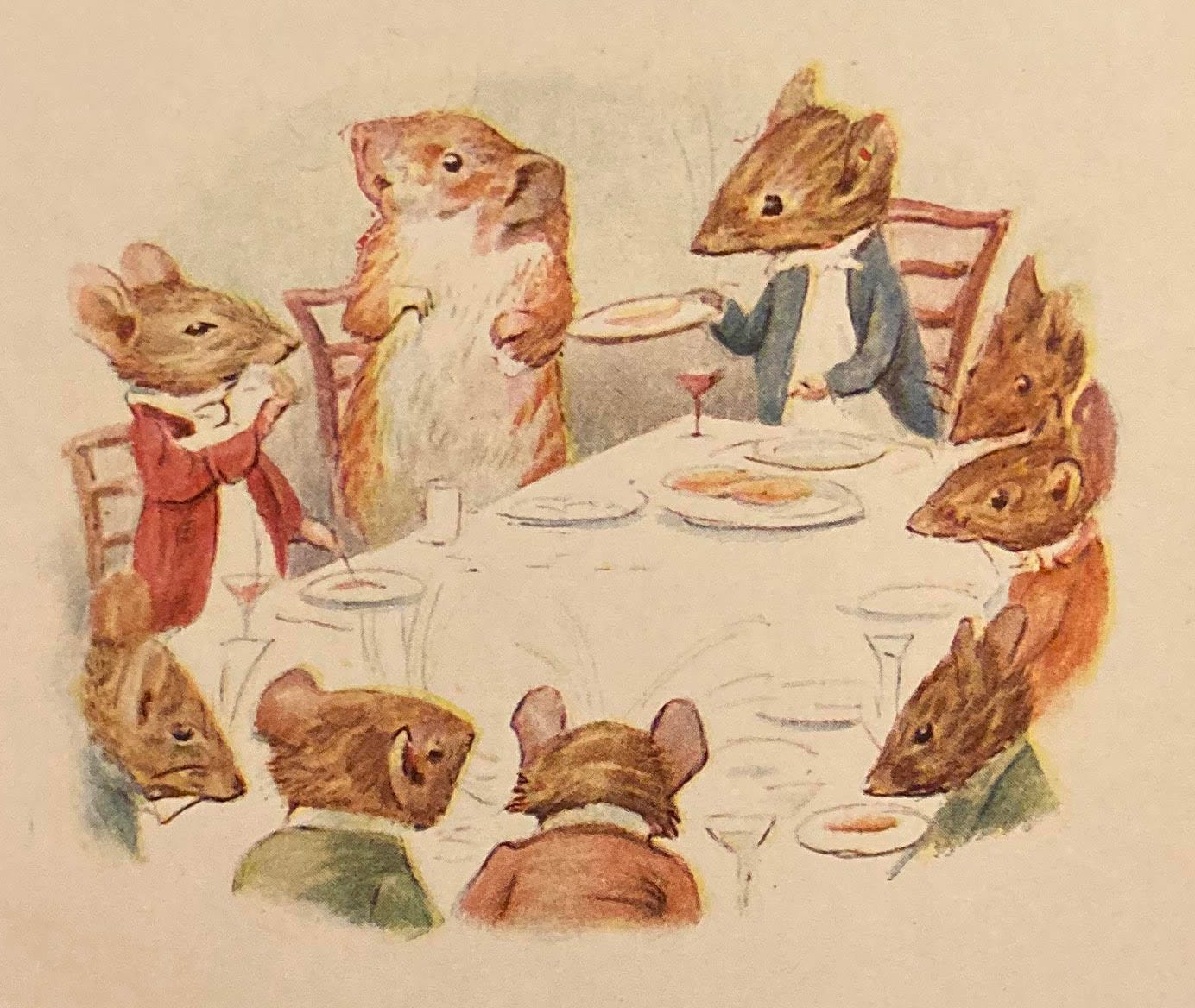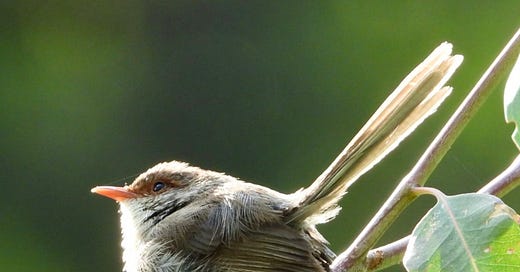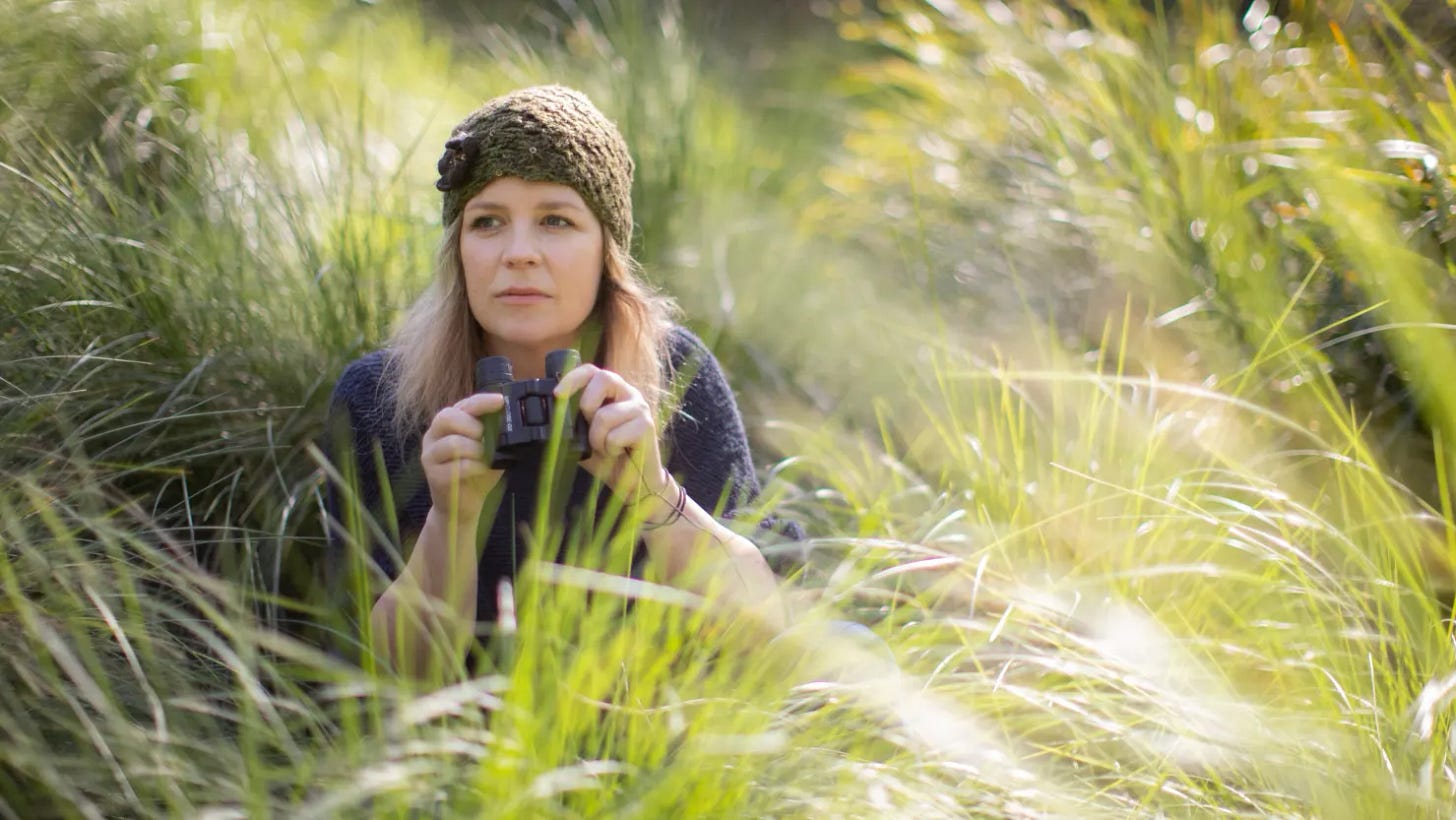Birds Are Like Ideas
How our non-writing hobbies feed our understanding of the creative process
Nabokov studied butterflies and moths, Emily Dickinson baked, Madeline L’Engle played piano. And I go birding. No one is more surprised than me by the hobby I’ve acquired since living in Australia — except, perhaps, my mum.
Town Mouse V. Country Mouse
I grew up in a house where one of the battle lines was country V. city, a battle that continues though my parents are in their seventies. They’ve spent their married life in London because Mum needs the vapours if she crosses the M25. Anything with a country vibe to it — baking, hiking, going near a cow — makes her nervous, and when Mum is nervous she’s funny and outrageous and takes no prisoners. When Granny on Dad’s side wrote notes in our birthday cards about robins visiting her garden, Mum coined the phrase “twitterings and rustlings” and said it as witheringly as Maggie Smith in Downton Abbey.

There’s a lesser-known Beatrix Potter book called The Tale of Johnny Town-Mouse that has always held meaning for me. Timmy Willie is a country mouse who goes to town by accident when he’s carried off in a hamper. On arrival he’s terrified. He lands atop the refined dinner table of Johnny Town-Mouse, whose dapper friends are well-bred enough not to mention Timmy’s insignificant tail (or the fact that he’s naked).
Eventually Johnny realises how unhappy Timmy is away from home and arranges his passage, half-promising a visit even though life there sounds exceedingly dull. When Johnny does visit, it’s a disaster — the damp, the mud, the noises, but equally how quiet it is! Johnny returns to town in bits and that’s that — we don’t even know if they write. They certainly don’t get married, live in London and have four mice children who love the countryside and the town equally.
History repeats itself, of course. I didn’t mean to live in Australia forever, that’s just how it’s turned out, and my heart’s been cleaved down the middle. For a long time I thought I could keep up with both sides of the world, and I still have moments when I try, but being an intense soul my work and heart have wanted to know Australia deeply. I’m here, in almost every sense. And to be here has meant lesson after lesson in flora, fauna and culture: what is this tree, who is this author, whose country am I on . . . and on, and on.
Out of nowhere, I latched onto birds
Maybe it’s my childhood flying dreams, maybe it was my Granny’s “twitterings and rustlings”, maybe I’m part country mouse, but birding is now my hobby. I can identify some of them by song, I’ve written the life story of an ornithologist for children, and Australia’s great camouflagers the tawny frogmouth can’t hide from me. For ages I’ve documented bird discoveries with a model of iPhone you haven’t been able to buy for years, and I’ve shared some of it on social media knowing they’re as dire as iPhone photos of the moon. Then along came Christmas.
We’d finished opening the presents, or so I thought, when my partner put a largish box in my lap. He’s always been the better present-buyer so I was braced, but when I tore a strip of festive wrapping and saw the word camera, I burst into tears. I don’t have a natural eye for photography so I’ve never considered investing in a camera, but he’d made the investment on my behalf.
Simply: do the thing you love.

The challenge of taking yourself seriously enough to invest time, money, or your heart, is something all writers know about. In the past few weeks of using the camera, I’ve been able to articulate why for me birding is a good compliment for writing.
Birds are like ideas
On Boxing Day I’d started along a river path that I know to be long, narrow and precarious: steep on both sides and no turning back once you’re on it because it’s difficult to pass other people. It was 6.30am and deserted. I suddenly got the jitters about being alone. Although I always walk by myself, I decided to turn back while I still could. The moment I did, I looked up and there she was: a tawny frogmouth doing such a good job of camouflage that I’d missed her the first time. In not striving but being in a noticing mode, the prize was awarded. I was ready, even though I wasn’t at that precise second in the act of looking.
Finding the right way in a novel is like this. You have to get yourself into a receptive state — some days that looks like putting all of your ideas on a big piece of paper (I mentioned in Write Around Your Life that I love an A3 pad). Other days it looks more like rest, from the outside, but you are ready to receive. Both require a kind of devotion.
Capturing the bird is another thing
What I see through the camera lens is divine. But sometimes the bird (or the idea) is too far away. If I’m clumsy it’ll take flight. Deciding how close to get is nail-biting, but to an outsider it doesn’t look like I’m doing much: they can’t hear my heart. When I press the button I think I’ve got something good. I want to look at it right there in the bush but if I spend too long doing that it’s like looking at photos of your kids when you’re in the same room as them and they want your attention.
Later, going through the shots at home, most aren’t as focussed as I thought, or a branch spoils the composition, or the bird’s eye is dull. I’ll edit the photos, and then there’s the worry about whether I’m making them better or worse.
You see how this is like writing, then.
The Challenge of Interruptions
Our writing practice is fragile — birding without interference is also a challenge. If you stand around with a bloody big camera you draw attention to yourself. Sometimes it’s lovely pointing out a tawny frogmouth or a kookaburra to a curious passing child. But to concentrate properly I have to be solitary.
When I went into the quiet first thing on New Year’s Day I got a great shot within minutes. That only made me greedy for more. Trying to capture a bird I rarely see, I’d been standing under a tree waiting for it to rest in a place where the light was better. The next thing I know, there’s a Great Dane resting her head on my shoulder, growling deeply — affectionately but with an edge of “I could eat you”. The woman holding its lead wanted to know what I was doing and seemed unaware that she was walking Clifford. I’m not afraid of dogs, and didn’t want to start the new year by yelling “The black-faced cuckoo shrike has gone, you total courgette!” But really.
Old Worries
The photos I’ve taken with my new camera make me happy. I’ve shared a few on social media. Here’s a thing I do, I’m saying. Are you impressed or what? But it’s also an act of sharing that surpasses ego, which is also true of writing fiction. I want to put something lovely into the world — into the hard chaos of the internet, when it comes to birds, or into the mind of a reader, when it comes to novels.
As it turns out, my mum is the biggest fan of both my birds photos and my books. She loves my “twitterings and rustlings” despite herself.
But the same doubts arise. When I see a real birder’s photos, my own are dull with poor composition and horrible editing. I assume that my ability to locate birds will always be disproportionate to my skill in capturing them.
This is also how I think of writing. Is my greatest creative skill tenacity? Do I understand story but lack the writing skills? Is my entire career down to persistence? Am I simply an incredible hoodwinker of publishers?
When will they get sick of me, and fly away?






Twitterings and rustlings!!
you are no hoodwinker! Your photos are great. I am still feeling great shame from calling the frogmouth an owl. Lately we are loving the bats but my photos of them are all sky.